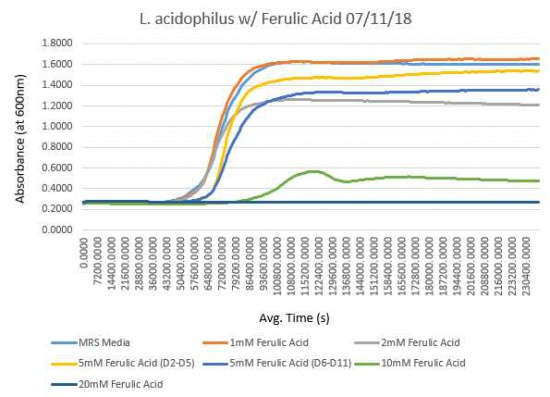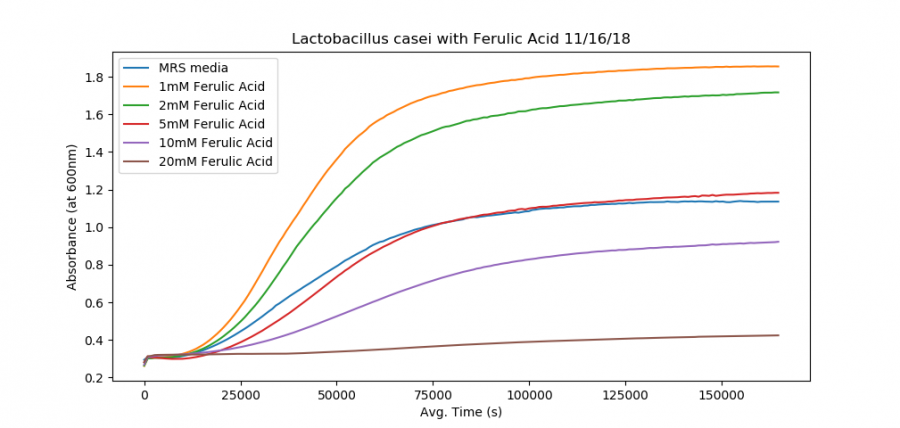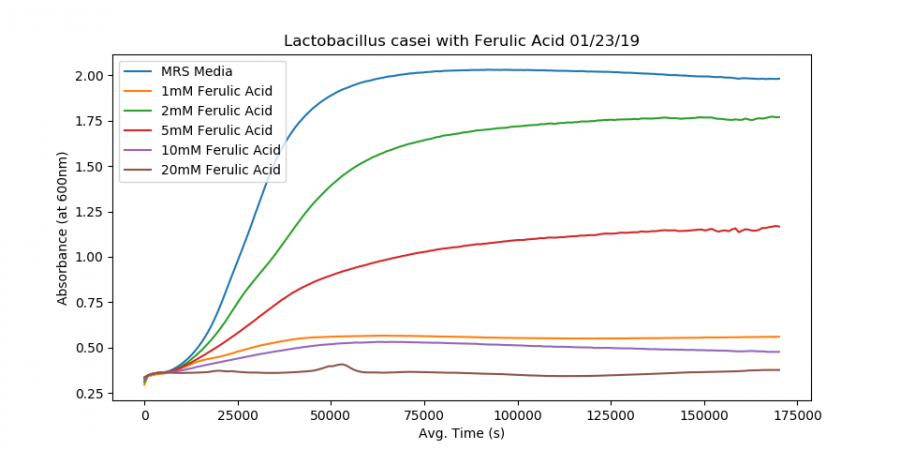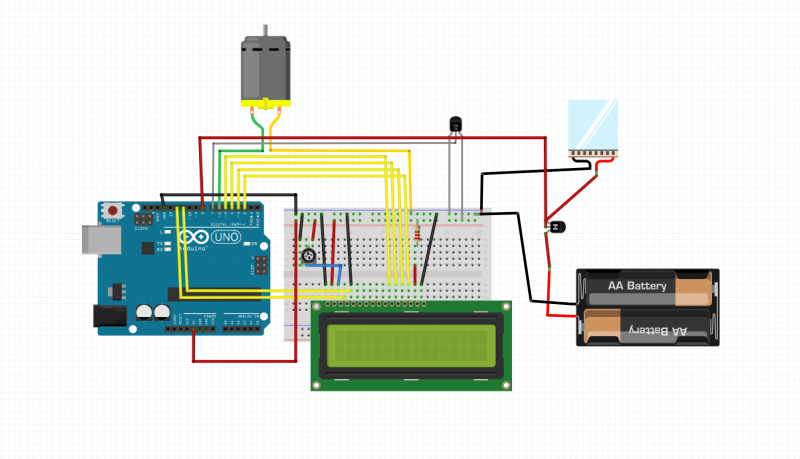Difference between revisions of "Studying the Affect of Lignin Monomers and Their Oxidation Products on Bacteria"
| (6 intermediate revisions by the same user not shown) | |||
| Line 1: | Line 1: | ||
| + | You have reached the page dedicated to the research of studying the affect of lignin monomers and their oxidation products on bacteria beginning during the summer of 2018 with the Doc Kieft Summer Research Program and extending to the present. This research is completed by Katelyn Richter under the direction of Dr. Bradley Sturgeon and Dr. Laura Moore. | ||
| + | |||
===[https://en.wikipedia.org/wiki/Lignin Lignin] Monomers=== | ===[https://en.wikipedia.org/wiki/Lignin Lignin] Monomers=== | ||
| Line 7: | Line 9: | ||
:[https://en.wikipedia.org/wiki/Sinapyl_alcohol sinapyl alcohol] | :[https://en.wikipedia.org/wiki/Sinapyl_alcohol sinapyl alcohol] | ||
| − | == | + | ==Abstract== |
| + | |||
| + | The many microbes inhabiting the human body compose the human microbiome. Without these microorganisms, the body would cease to exist. While they are miniscule alone, in large numbers they are a force to be reckoned with. Gut microbes specifically play an enormous role in the body. The gateway to human health can be defined as the gut microbiome. A human’s diet plays a huge role in determining the variety of bacteria in his or her gut microbiomes, which in turn determines overall health, resistance to disease and sickness, and even plays a role in influencing thoughts and emotions. Lignin monomers have been noticed to have interesting applications in nature. When lignin monomers are added in small doses to some bacteria, it can sometimes help the bacteria grow better than normal media alone. | ||
| + | |||
| + | ==Methods== | ||
| + | |||
| + | Experimentation was done first with ''Lactobacillus acidophilus'' and ferulic acid, a precursor to coniferyl alcohol. ''L. acidophilus'' was streaked onto MRS media plates and left to incubate at 37°C for approximately 2-3 days per plate. A colony was then picked from the plate and grown up in 10mL of MRS Media in an incubator shaker at 37°C for approximately 3 days. After this period, a 96 well plate was filled with the bacteria and varying low concentrations of ferulic acid, keeping the same concentration of ferulic acid in each row. The plate was then run in the plate reader for approximately 48 hours, and data was analyzed to look for growth of the bacteria under the conditions of each concentration. | ||
| + | |||
| + | ''Lactobacillus acidophilus'' did not yield the most promising results, so new experimentation on ''Lactobacillus casei'' has most recently begun. The protocols for experimentation on ''L. casei'' are the same as those for ''L. acidophilus''. | ||
| + | |||
==Results== | ==Results== | ||
| − | == | + | ===''Lactobacillus acidophilus''=== |
| + | |||
| + | [[File:ferulicacid_acidophilus_071118_graph.jpg|550px]] | ||
| + | |||
| + | ''Figure 1:'' Plate reader data of trial with ''L. acidophilus'' and increasing concentrations of ferulic acid in MRS media. | ||
| + | |||
| + | ===''Lactobacillus casei''=== | ||
| + | |||
| + | [[File:casei_FA_111618_graph.png|900px]] | ||
| + | |||
| + | ''Figure 1:'' Plate reader data of trial with ''L. casei'' and increasing concentrations of ferulic acid in MRS media. Note that 1mM ad 2mM concentrations of ferulic acid caused ''L. casei'' to grow larger amounts more quickly than MRS media alone. | ||
| + | |||
| + | [[File:casei_FA_012319_graph.png|900px]] | ||
| + | |||
| + | ''Figure 2:'' Plate reader data of trial with ''L. casei'' and increasing concentrations of ferulic acid in MRS media. This trial did not yield the same results as the trial from Figure 1 for unknown reasons. | ||
| + | |||
| + | Experimentation with ''L. casei'' and ferulic acid is still in progress. | ||
| + | |||
| + | ==Anaerobic Chamber== | ||
| + | |||
| + | A collaboration with Seth Croslow is currently in motion to build an anaerobic chamber to better facilitate the growth of gut bacteria. | ||
| + | |||
| + | ===Background=== | ||
| + | |||
| + | Gut bacteria grow under anaerobic conditions inside the body; however, we do not have the proper equipment to effectively mimic the environment of a human gut at this time. Currently, we grow this bacteria in the incubator shaker and the plate reader, but this can only be done in an aerobic environment. Ideally, the bacteria would be grown and experimented upon in an anaerobic chamber (otherwise known as a glove box). Therefore, we would like to build our own version of a glove box to provide the necessary environment to best facilitate the growth of common types of gut bacteria for experimentation. | ||
| + | |||
| + | ===Construction=== | ||
| + | |||
| + | The construction of the anaerobic chamber will be simple and will only require a few components listed below (Note: an X represents that we currently have the item): | ||
| + | |||
| + | Plastic tote | ||
| + | |||
| + | Power supply (specs TBD) X? | ||
| + | |||
| + | Arduino Uno X | ||
| + | |||
| + | Peltier Module X | ||
| + | |||
| + | Heat Sink X | ||
| + | |||
| + | Transistor X | ||
| + | |||
| + | LCD Screen X | ||
| + | |||
| + | Rotary Potentiometer X | ||
| + | |||
| + | Temperature Sensor X | ||
| + | |||
| + | Foam/sealer(caulk?) | ||
| + | |||
| + | Valves (2x) | ||
| + | |||
| + | Estimated Cost: $50 | ||
| + | |||
| + | The setup is simple, the plastic tote will be sealed using the foam and cutouts will be made for the peltier module and temperature sensor. The peltier module and fan will be used to regulate the temperature and will be attached to the side of tote. The Arduino, power supply, and LCD screen will be housed in a separate container (made via 3D printing). A simple circuit will be made to power and control all of the peripherals and software will be written using Arduino IDE. | ||
| + | |||
| + | ===Usage=== | ||
| + | |||
| + | Once finished, the plate reader can be placed into the tote as well as some dry ice. Once the dry ice sublimates, it will displace the air within the tote which will then escape through a valve on the top of the tote. Then, nitrogen will be filled into the container from a valve in the top to remove the CO2 and thus produce the anaerobic conditions necessary. The peltier module will then be turned on and the temperature will be increased until 37℃ is reached; this temperature will then be held constant. | ||
| + | |||
| + | ===Sample Circuit=== | ||
| − | + | [[File:samplecircuit_1.png|800px]] | |
Latest revision as of 14:49, 2 May 2019
You have reached the page dedicated to the research of studying the affect of lignin monomers and their oxidation products on bacteria beginning during the summer of 2018 with the Doc Kieft Summer Research Program and extending to the present. This research is completed by Katelyn Richter under the direction of Dr. Bradley Sturgeon and Dr. Laura Moore.
Lignin Monomers
Abstract
The many microbes inhabiting the human body compose the human microbiome. Without these microorganisms, the body would cease to exist. While they are miniscule alone, in large numbers they are a force to be reckoned with. Gut microbes specifically play an enormous role in the body. The gateway to human health can be defined as the gut microbiome. A human’s diet plays a huge role in determining the variety of bacteria in his or her gut microbiomes, which in turn determines overall health, resistance to disease and sickness, and even plays a role in influencing thoughts and emotions. Lignin monomers have been noticed to have interesting applications in nature. When lignin monomers are added in small doses to some bacteria, it can sometimes help the bacteria grow better than normal media alone.
Methods
Experimentation was done first with Lactobacillus acidophilus and ferulic acid, a precursor to coniferyl alcohol. L. acidophilus was streaked onto MRS media plates and left to incubate at 37°C for approximately 2-3 days per plate. A colony was then picked from the plate and grown up in 10mL of MRS Media in an incubator shaker at 37°C for approximately 3 days. After this period, a 96 well plate was filled with the bacteria and varying low concentrations of ferulic acid, keeping the same concentration of ferulic acid in each row. The plate was then run in the plate reader for approximately 48 hours, and data was analyzed to look for growth of the bacteria under the conditions of each concentration.
Lactobacillus acidophilus did not yield the most promising results, so new experimentation on Lactobacillus casei has most recently begun. The protocols for experimentation on L. casei are the same as those for L. acidophilus.
Results
Lactobacillus acidophilus
Figure 1: Plate reader data of trial with L. acidophilus and increasing concentrations of ferulic acid in MRS media.
Lactobacillus casei
Figure 1: Plate reader data of trial with L. casei and increasing concentrations of ferulic acid in MRS media. Note that 1mM ad 2mM concentrations of ferulic acid caused L. casei to grow larger amounts more quickly than MRS media alone.
Figure 2: Plate reader data of trial with L. casei and increasing concentrations of ferulic acid in MRS media. This trial did not yield the same results as the trial from Figure 1 for unknown reasons.
Experimentation with L. casei and ferulic acid is still in progress.
Anaerobic Chamber
A collaboration with Seth Croslow is currently in motion to build an anaerobic chamber to better facilitate the growth of gut bacteria.
Background
Gut bacteria grow under anaerobic conditions inside the body; however, we do not have the proper equipment to effectively mimic the environment of a human gut at this time. Currently, we grow this bacteria in the incubator shaker and the plate reader, but this can only be done in an aerobic environment. Ideally, the bacteria would be grown and experimented upon in an anaerobic chamber (otherwise known as a glove box). Therefore, we would like to build our own version of a glove box to provide the necessary environment to best facilitate the growth of common types of gut bacteria for experimentation.
Construction
The construction of the anaerobic chamber will be simple and will only require a few components listed below (Note: an X represents that we currently have the item):
Plastic tote
Power supply (specs TBD) X?
Arduino Uno X
Peltier Module X
Heat Sink X
Transistor X
LCD Screen X
Rotary Potentiometer X
Temperature Sensor X
Foam/sealer(caulk?)
Valves (2x)
Estimated Cost: $50
The setup is simple, the plastic tote will be sealed using the foam and cutouts will be made for the peltier module and temperature sensor. The peltier module and fan will be used to regulate the temperature and will be attached to the side of tote. The Arduino, power supply, and LCD screen will be housed in a separate container (made via 3D printing). A simple circuit will be made to power and control all of the peripherals and software will be written using Arduino IDE.
Usage
Once finished, the plate reader can be placed into the tote as well as some dry ice. Once the dry ice sublimates, it will displace the air within the tote which will then escape through a valve on the top of the tote. Then, nitrogen will be filled into the container from a valve in the top to remove the CO2 and thus produce the anaerobic conditions necessary. The peltier module will then be turned on and the temperature will be increased until 37℃ is reached; this temperature will then be held constant.



